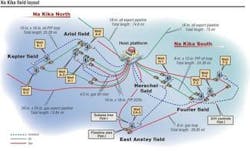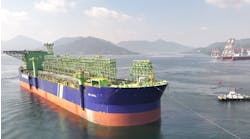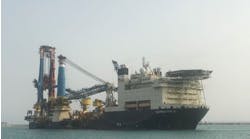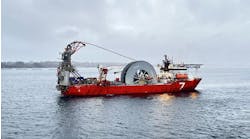The lowdown on blow down
William Furlow
Editor-in-Chief
With subsea tiebacks that are updip of the host platform, flow assurance engineers on the Na Kika develop-ment in the Gulf of Mexico had to design a unique hydrate manage-ment system to take the place of blow down during system shut in.
The Na Kika host platform is unique because it does not have a primary field. Rather, it was installed at a central location on Mississippi Canyon block 474 among six relatively small, subsea fields that tie back to it. Four are south of Na Kika in deeper water. Two are north in water that is considerably shallower than the host. The southern fields all tie into two flowline loops.
The north loop ties together two distinct fields, Ariel and Kepler, for a total of five subsea wells. The north loop is unique because, to reach the base of the host risers, the production has to flow "downdip," according to Kent Stingl, Na Kika project subsea and pipeline team leader for Shell International E&P Co.
Transient conditions
In deepwater, flow assurance concerns increase during transient conditions, such as the shut in or start up of production. As long as production is flowing, the heat it carries with it from the formation keeps it from icing up. Deepwater oil flowlines are often insulated to help retain this heat as the flow travels through the cold water.
When an oil and gas condensate field is shut in, the production in the line is static, and it begins to lose heat. At the same time, the gas fraction in the flow stream migrates up the flowline to its highest point, assisted by density.
In a typical hub-and-spoke design, the subsea wells are tied back to a host in shallower water so the production flows updip toward the base of the risers on the host. That means when production is shut in, the gas migrates toward the host. During shut in, Stingl said, the operator can avoid hydrate formation by lowering the pressure in the riser. In effect, bleeding off the gas pressure means the flow will remain safely out of the hydrate range at a lower temperature.
The Na Kika subsea field layout shows wells installed in a number of fields at various depths. All of these feed into the host platform.
null
In the case of the Na Kika North Loop, gravity works against this solution. Because the subsea wells are updip of the platform, the gas naturally migrates back to the subsea wellheads. There is no practical way to blow down this gas, so when production must be shut in, another flow assurance solution has to be used.
It is unusual for a subsea well to be tied back downhill to a host, but it is not that unusual for the production from a subsea well to have a low gas-to-oil ratio (GOR). If there is not a great enough gas fraction in the production mix, then the blow down method will not be effective. This is a second, more common, condition where an alternative flow assurance solution would be needed in the case of shut in.
Some of the wells in the south loop may have a very low GOR. Even though these wells are downdip of the host, the blow down method might now work effectively because there is simply not enough gas present in the lines.
On the southern gas loop, there is no need for this system because blow down is an obvious choice. These flowlines also require injection of hydrate inhibitors to avoid the formation of ices.
Once the production is shut in and ceases to flow, Stingl said, hydrocarbons can safely remain in the flowlines for up to 12 hours. Insulation retains heat for this period, but any longer and hydrates begin to form, potentially causing blockage.
Dead oil
Dead oil is a term commonly used to describe oil with no trace of water or gas. While any flowline that contains water and gas can form hydrates, given the proper conditions, oil is immune to this threat. Dead oil can sit static in a flowline for an extended period without the risk of ice formation.
So when the north flow loop on Na Kika has to be shut in, the live production is circulated out in front of a pig propelled by dead oil. This serves a two-fold purpose. It pigs the entire line clean, removing any corrosion, water, or waxes that may be present. It also fills the line with oil that will not ice up at the low temperatures of deepwater.
Once it is time to start up production again, the dead oil is circulated out using heated oil from the same dead oil storage tanks. This oil is run across a heat exchanger on the host and pumped into the flowline at about 170° F. The hot oil is then circulated through the insulated line until the return temperature is up to 110° F. Then the oil is circulated out, and production resumes. This method addresses a critical step in the transition process, the cold start. If production were introduced into a cold flowline without injecting large volumes of MeOH, then it would ice up before reaching the host. The circulated oil warms the flowline so that it is safe to resume production.
Pump rates
Na Kika stores 24,000 bbl of dead oil for this purpose. Stingl said it requires about 11,000 bbl to fill the 26-mi-long north loop. While this oil is pumped at a relatively low pressure, it was critical to have high pump rates given the narrow time window between shut in and cool down. The oil must be pumped at between 50,000 and 60,000 b/d to displace the entire loop within 6 hours. The system was designed so it could circulate dead oil through both the north and south loops simultaneously, with excess capacity to accommodate future tiebacks.




